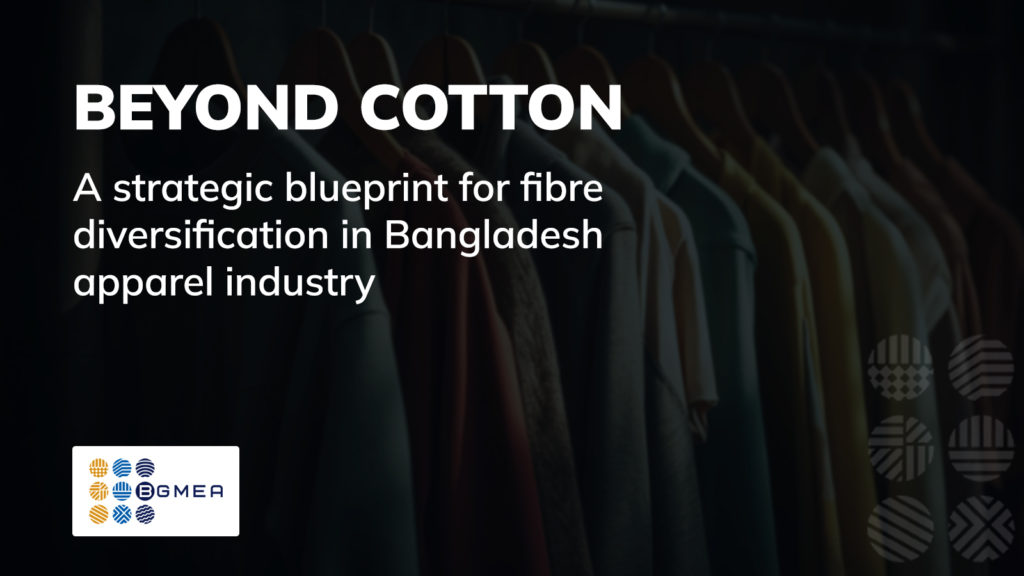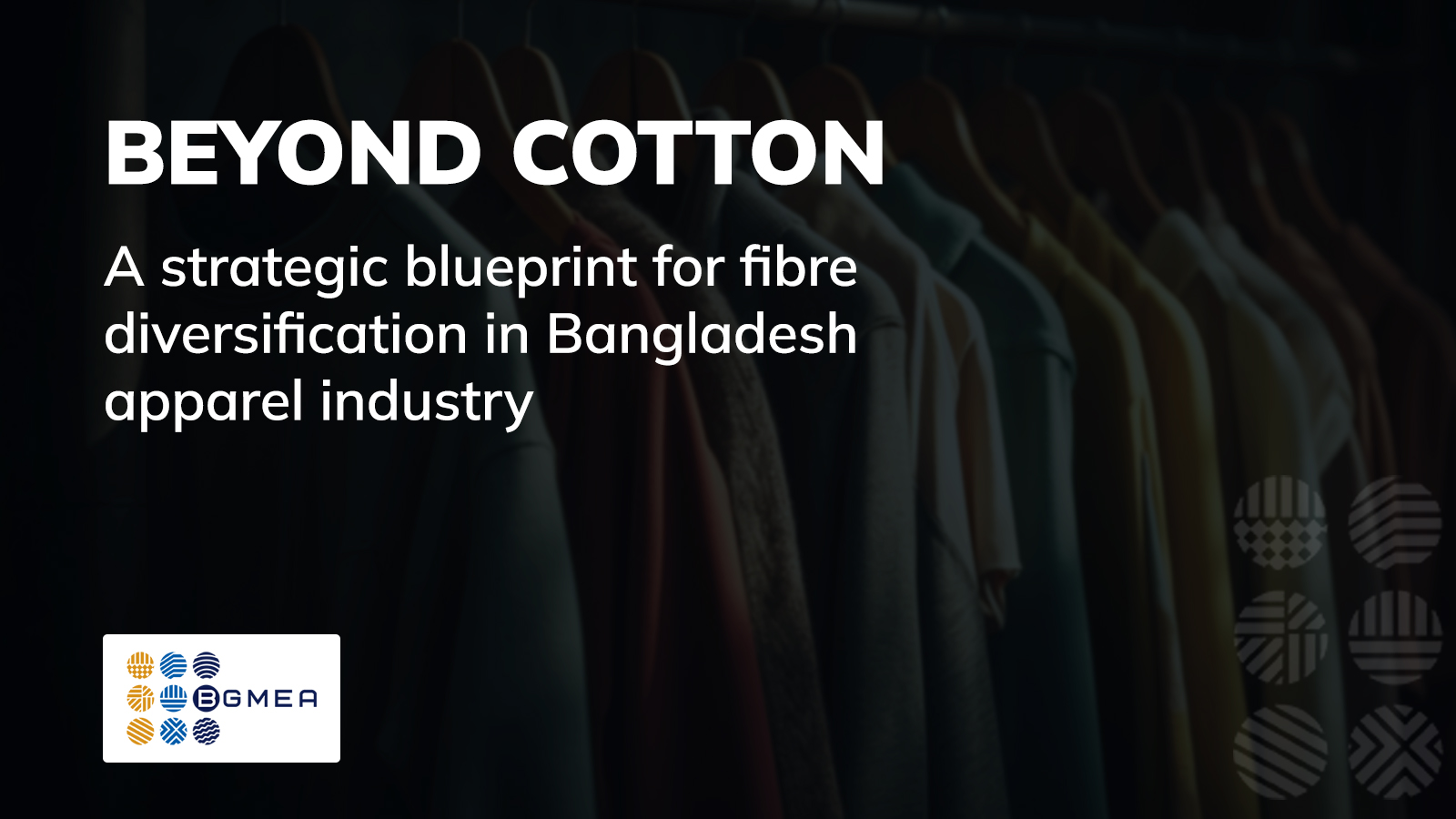
Beyond Cotton: A Strategic Blueprint for Fibre Diversification in Bangladesh Apparel Industry
The Bangladesh Garment Manufacturers and Exporters Association (BGMEA) stands as one of the largest trade associations in Bangladesh. Its focus is on representing the expansive readymade garment industry, particularly woven garments, knitwear, and the sweater sub-sectors. Recognizing the evolving landscape of the global apparel industry towards man-made fibres, BGMEA engaged Wazir Advisors to study the potential of Fibre diversification of non-cotton textile and apparel for Bangladesh in the global apparel market.
The study aims to explore the potential scope for Bangladesh in the global non-cotton textile and apparel market. Its primary objective is to devise a comprehensive strategy that enhances the country’s overall competitiveness and strength in this sector. Through an in-depth analysis, the study scrutinizes various non-cotton product categories, examining their intricacies, resource requirements, and trade volumes along with the economic, demand, and sustainability aspects of non-cotton apparels. A critical aspect of the study involves identifying and addressing key challenges that currently impede Bangladesh from securing a significant share in the non-cotton apparel market.
The study provides a roadmap offering actionable insights for manufacturers, investors, policymakers, development partners, and other stakeholders in order to enhance Bangladesh’s overall competitiveness and fortify its position in the domain of non-cotton apparel manufacturing.
Non-cotton textile and apparel trends in Global and Bangladesh Industry
Production: Over the past five years, there has been a notable surge in global non-cotton fibre production, capturing an impressive 78% share of the total fibre production. In contrast, cotton fibre production has faced a decline during the same period. Synthetic Fibre hold the largest share in the non-cotton Fibre production with Polyester Filament Yarn (PFY) being the highest contributor, commanding a significant 39% share, followed by Polyester Staple Fibre (PSF) at 15%. Other man-made fibres such as Nylon Filament Yarn (NFY) and Viscose Staple Fibre (VSF) hold limited shares, however their productions have experienced steady growth. Conversely, Acrylic Staple Fibre (ASF) has experienced a decrease in production share, dropping from 1.7% in 2017 to 1.4% in 2022. Wool and silk make negligible contributions with production shares of 1% and 0.1%, respectively.
Trade: The global trade of both cotton and non-cotton fibre has seen minimal growth of 1% from 2018 to 2022. Notably, the trade of polyester fibre has declined at a CAGR of -3%, while that of polyester yarn and fabric have grown by 1% and 2%, respectively, over the past five years. Conversely, Nylon fibre, yarn, and fabric trade has experienced declines with CAGR of -2%, -1%, and -2%, respectively. Although global VSF trade has grown, exports of Viscose yarn and fabrics have declined in the same period. Acrylic Fibre and yarn trade have declined notably with CAGR of -6% and -3% respectively, while acrylic fabric exports have increased since 2018.
Wool fibre, yarn, and fabric trade have also notably decreased over the last five years. The decline in overall non-cotton fibre trade, coupled with an increase in production capacity, signifies greater consumption of non-cotton fibre within the producing nations.
In global apparel trade, Non-cotton apparel have emerged as a larger and faster-growing category than cotton apparel. Leading exporters like China, Vietnam, Italy, and Spain heavily contribute to the exports of non-cotton apparel accounting for more than 50% of the total exports. In contrast, cotton-producing countries such as India and Turkey exhibit a lower share of non-cotton apparel exports. Bangladesh, despite not being a cotton growing nation, stands out with a substantial share in cotton apparel exports.
The non-cotton apparel trade emphasizes product diversity, as the top 10 exported categories only command a combined share of 44%, highlighting the need to focus on multiple products for a meaningful global market share. Among the fastest-growing non-cotton categories globally, Jerseys and Pullovers of Man-Made Fibres (MMF) lead the way, and women’s wear categories (outerwear, dresses, and trousers) dominate the list.
Bangladesh has achieved notable progress in the global apparel market, securing the second position following China. With China’s presence diminishing in the global apparel market over the past decade, Bangladesh has effectively seized a substantial portion of the market share vacated by China in the apparel sector. The share of non-cotton apparel from Bangladesh, although currently lesser than cotton apparel, is experiencing a rapid increase in the export market. This trend suggests a growing inclination among buyers to source various types of apparel from Bangladesh.
The country’s cotton apparel exports exhibit a high concentration, primarily focusing on four categories that collectively command a significant 63% share. Notably, these categories include t-shirts (21%), jerseys (12%), and woven trousers (30%). In terms of non-cotton apparel, Bangladesh aligns closely with global market demands. The top non-cotton apparel categories exported from Bangladesh correspond broadly to the top ten non-cotton categories traded on a global scale indicating the alignment with the current market demands of specific products. Furthermore, the fastest-growing non-cotton categories in Bangladesh mirror the trends observed in those traded globally. This synchronization underscores the adaptability and responsiveness of Bangladesh-based manufacturers to the dynamic and evolving demands of the global apparel market.
Key Primary Research Findings
Manufacturers have recognized the importance of establishing upstream manufacturing capabilities for non-cotton textiles in Bangladesh. While there is a willingness to undertake such endeavours, several factors impede the realization of these aspirations. Challenges such as shortage of technical manpower, reliance on imported raw materials, high manufacturing cost, and significant capital expenditure requirements pose constraints on investments in projects geared towards non-cotton manufacturing.
In the global marketplace, the competitive pricing and quality offerings of Chinese manufacturers have long been acknowledged. Despite these advantages, buyers are increasingly expressing interest in shifting their non-cotton apparel sourcing base to Bangladesh, primarily driven by geopolitical considerations. However, Bangladesh faces its own set of challenges in this transition, including limited product range, higher prices, and concerns related to quality inconsistency, which are key considerations for buyers.
While investments in non-cotton textile ventures are gradually emerging in Bangladesh, the pace remains suboptimal. The capital-intensive nature of such initiatives, coupled with high interest rates, the absence of non-cotton focused government policies, deficiency in technical competency, and inconsistent availability of power collectively act as major impediments to the expansion of non-cotton textiles in the country.
Although government support exists for the overall expansion of the Textile and Apparel (T&A) industry, the absence of specific policies addressing non-cotton diversification is a notable gap. A lack of targeted initiatives tailored to the unique needs of non-cotton textiles hinders the sector’s potential for growth and diversification.
Competitor Mapping
China takes the lead in the domain of non-cotton textiles, holding a significant portion of global exports throughout the entire value chain. This dominance is driven by its remarkable price competitiveness, diverse product offerings, and extensive large-scale setups. Notably, outerwear emerges as the largest exported non-cotton apparel category from both China and Bangladesh, with 34% and 38% share respectively. On the other hand, top-wear leads in India’s exports, contributing to 24% of the non-cotton apparel exports in 2022, while innerwear is the primary category in Taiwan’s exports.
The United States and EU are key markets for non-cotton apparel for China, Taiwan, India, and Bangladesh. Encouragingly, all these countries actively offer favourable government incentives to stimulate investment in the non-cotton textile sector. However, despite these incentives, Bangladesh faces its own set of challenges, with lower power and labour costs acting as advantages but a notable lag in lending rates hindering its overall competitiveness.
Recommendations for future growth
Looking ahead to 2032, Bangladesh should aim to achieve a sustained double-digit growth rate in non-cotton apparel exports, aspiring to elevate these exports from the 2022 figure of US$ 15.6 bn to an ambitious US$ 42 bn. The anticipated expansion is grounded in the strategic objective of creating a comprehensive value chain and reducing reliance on imports. To realize this vision, it is imperative for the country to develop a dedicated policy for the non-cotton industry, encompassing a clearly defined vision, mission, and actionable points that specifically address the key challenges of insufficient technical know-how and limited upstream capacities.
Realizing the magnitude of this transformative vision, an estimated investment of approx. US$ 18 billion will be required to forge a fully integrated value chain that aligns with the aspirations set for Vision 2032.
To enhance the technical expertise of Bangladesh’s non-cotton industry and emphasize upstream value addition, a collaborative effort from policymakers, industry bodies, and players within the sector is essential.
Download the Full Report

|
Interested to learn more? |

